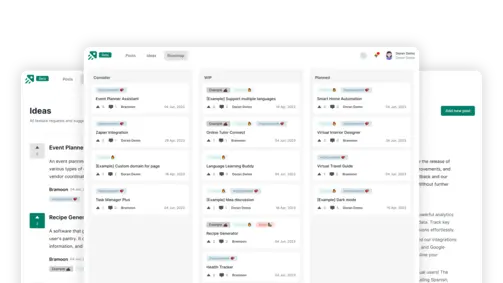CSAT vs NPS vs CES Comparison: Choosing the Right Customer Metric
Create changelog and product roadmap for your product
Explore nowTable of contents 8 min
In the realm of customer feedback metrics, the comparison between CSAT vs NPS vs CES sparks insightful discussions for businesses aiming to gauge customer sentiments. While both metrics offer valuable insights, understanding the nuances and applications of CSAT vs NPS vs CES is essential. This guide delves into the distinctions, benefits, and scenarios where each metric shines, providing businesses with clarity in selecting the right approach for measuring customer satisfaction.
Overview of CSAT vs NPS vs CES

Customer satisfaction is a multifaceted concept that businesses strive to understand and improve continuously. Three widely used metrics – Customer Satisfaction (CSAT), Net Promoter Score (NPS), and Customer Effort Score (CES) – play pivotal roles in assessing and enhancing customer satisfaction. In this comprehensive article, we’ll explore the intricacies of each metric, understand their unique features, and examine how businesses can leverage them to achieve customer-centric success.
Customer Satisfaction (CSAT)
CSAT is a metric designed to measure the overall satisfaction of customers with a particular product, service, or interaction. Typically expressed as a percentage, CSAT surveys often ask customers to rate their satisfaction on a scale, with options ranging from “Very Unsatisfied” to “Very Satisfied.” The resulting score provides a snapshot of customer contentment and identifies areas for improvement.
Read more: CSAT survey: Definition, Questionnaire, Templates & Examples
Net Promoter Score (NPS)
NPS gauges customer loyalty and likelihood to recommend a brand. Respondents are categorized into Promoters (loyal customers), Passives (satisfied but not enthusiastic), and Detractors (unhappy customers). The NPS is calculated by subtracting the percentage of Detractors from the percentage of Promoters. NPS values can range from -100 to 100, with higher scores indicating a greater likelihood of customer advocacy.
Find out more: The Power of NPS Surveys: Unlocking Customer Loyalty
Customer Effort Score (CES)
CES measures the ease with which customers can accomplish a specific task or resolve an issue. It aims to identify the effort customers expend during interactions with a product, service, or brand. CES surveys often utilize scales or emoticons to quantify the perceived effort, providing actionable insights for businesses to streamline processes and enhance user experience.
The Importance of Choosing the Right Metrics to Measure Customer Satisfaction

Selecting the appropriate metrics for measuring customer service is a critical decision for businesses. The choice influences the accuracy of feedback, the identification of improvement areas, and the overall effectiveness of customer-centric strategies. Here are key reasons why the right metrics matter:
Precision in Measurement
Different aspects of customer satisfaction require distinct measurement approaches. CSAT vs NPS vs CES cater to various dimensions, allowing businesses to precisely capture the specific facets they aim to improve. A tailored approach ensures more accurate feedback and targeted improvements.
Actionable Insights
Effective metrics provide actionable insights that guide strategic decisions. Metrics that align with business objectives and customer expectations generate data that can be translated into tangible actions. This, in turn, helps businesses implement changes that resonate with customers and enhance their overall satisfaction.
By analyzing the data from CSAT vs NPS vs CES, businesses can identify trends and patterns that reveal areas of improvement. This allows them to prioritize their efforts and allocate resources effectively. Additionally, actionable insights enable businesses to track the impact of their initiatives over time and make necessary adjustments to continuously enhance customer satisfaction.
Holistic Understanding
Customer satisfaction is a multifaceted concept, and a single metric may not capture its entirety. Combining metrics allows businesses to gain a holistic understanding of the customer experience. A nuanced approach enables identification of overarching trends and specific pain points, leading to comprehensive improvement strategies. These comprehensive improvement strategies can result in enhanced customer satisfaction and loyalty.
Continuous Improvement
Choosing the right metrics supports a culture of continuous improvement. Regularly tracking and analyzing customer satisfaction metrics enable businesses to adapt to changing customer preferences, address emerging issues promptly, and stay ahead in the competitive landscape.
Additionally, continuous improvement allows businesses to stay proactive in identifying areas for growth and innovation. By consistently monitoring customer satisfaction metrics, companies can identify patterns and make necessary adjustments to their products or services to better meet customer needs. This not only helps in retaining existing customers but also attracts new ones, ultimately leading to business success.
Is CSAT vs NPS vs CES Convertible?

The question of convertibility revolves around the idea of interchangeability among CSAT vs NPS vs CES. While these metrics share the overarching goal of understanding and improving customer satisfaction, they serve distinct purposes and capture different dimensions of the customer experience.
CSAT to NPS
Converting CSAT vs. NPS involves understanding the correlation between overall satisfaction and the likelihood of customer advocacy. While high CSAT scores may suggest contentment, they don’t necessarily indicate a customer’s inclination to recommend the brand. Transitioning from CSAT to NPS requires additional insights into loyalty and advocacy.
NPS to CSAT
NPS focuses on loyalty and advocacy, but it doesn’t provide granular details about specific aspects of the customer experience that may contribute to dissatisfaction. Converting NPS vs. CSAT involves drilling down into the reasons behind the likelihood to recommend and identifying the areas requiring improvement for an enhanced overall satisfaction.
This conversion from NPS to CSAT allows businesses to identify specific pain points and areas of improvement in order to enhance overall customer satisfaction. By understanding the reasons behind customers’ likelihood to recommend, companies can address any issues and provide a more tailored and satisfactory experience.
CSAT and NPS to CES
CSAT and NPS may indirectly impact the perceived effort by influencing the overall satisfaction and loyalty of customers. However, converting CSAT and NPS to CES involves a more direct approach, as CES specifically measures the ease of customer interactions. While CSAT and NPS offer broader insights, CES delves into the specific efforts customers make during their journey.
This can include factors such as the number of steps required to complete a task, the clarity of instructions, and the amount of time and effort needed to resolve an issue. By focusing on CES, companies can identify pain points in the customer journey and make targeted improvements to enhance overall satisfaction and loyalty. Additionally, CES can provide valuable data for benchmarking and comparing performance against industry standards, allowing companies to stay competitive in delivering effortless customer experiences.
CES to CSAT and NPS
CES measures the tangible effort customers invest in various touchpoints, but it might not capture the emotional aspects of satisfaction and loyalty. Converting CES to CSAT and NPS involves complementing the data on perceived effort with insights into overall satisfaction and the likelihood of recommending the brand.
In essence, while these metrics may be interconnected, each serves a distinct purpose. Businesses aiming for a comprehensive understanding of customer satisfaction may choose to utilize a combination of CSAT, NPS, and CES, recognizing that each metric contributes unique insights to the overall picture.
Which is Better, CSAT vs NPS vs CES?
Determining the superiority of CSAT, NPS, or CES depends on various factors, including the nature of the business, the specific objectives of the measurement, and the desired depth of insights. Let’s explore the strengths and considerations of each metric to aid in the decision-making process.
Customer Satisfaction (CSAT)
Strengths:
-
Provides a straightforward measure of overall satisfaction.
-
Allows businesses to identify specific aspects of products or services that require improvement.
-
Easy for customers to understand and respond to.
Considerations:
-
May lack depth in understanding customer loyalty and advocacy.
-
Singular focus on satisfaction may overlook critical factors influencing customer behavior.
Net Promoter Score (NPS)
Strengths:
-
Captures customer loyalty and the likelihood of brand advocacy.
-
Segregates customers into distinct categories (Promoters, Passives, Detractors) for targeted strategies.
-
Simplicity in calculation and interpretation.
Considerations:
-
Might not provide detailed insights into specific pain points or areas for improvement.
-
Limited in measuring overall satisfaction beyond loyalty and advocacy.
Customer Effort Score (CES)
Strengths:
-
Directly measures the ease of customer interactions and identifies friction points.
-
Focuses on specific touchpoints, making it actionable for process optimization.
-
Provides insights into the tangible effort customers invest.
Considerations:
-
May not capture the emotional aspects of customer satisfaction.
-
Limited in assessing overall loyalty and brand advocacy.
Choosing the right metrics is not a one-size-fits-all decision. Instead, businesses should consider a holistic approach that combines the strengths of CSAT, NPS, and CES to gain a 360-degree view of the customer experience. By understanding the intricacies of each metric and their interplay, businesses can craft strategies that resonate with customers, foster loyalty, and drive sustainable success in today’s competitive market.
In conclusion, the journey towards optimal customer satisfaction involves navigating the nuances of CSAT vs NPS vs CES. The choice between these metrics depends on the goals, objectives, and unique characteristics of each business. Rather than viewing them as mutually exclusive, businesses can leverage the strengths of each metric to create a comprehensive and nuanced understanding of customer satisfaction.
What to not miss out on our blog
Gain insightful knowledge and invaluable experiences from dedicated experts.

CRM System Explained: Benefits, Types, and How It Works
Discover everything about CRM system. Learn the benefits and how a CRM system works to improve customer relationships and streamline business operations.

Are you ready? Start your free trial today.
Enhance communication, keep track of the progress, understand customers' insight and more by taking your first trial on Doran.
Sign up for free

